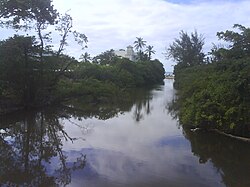Saint James, Barbados
| Saint James | |
|---|---|
| Parish | |
 |
|
 Map of Barbados showing the Saint James parish |
|
| Coordinates: 13°13′N 59°37′W / 13.217°N 59.617°WCoordinates: 13°13′N 59°37′W / 13.217°N 59.617°W | |
| Country | Barbados |
| Largest city | Holetown |
| Government | |
| • Type | Parliamentary democracy |
| • Parliamentry seats | 3 |
| Area | |
| • Total | 31 km2 (12 sq mi) |
| Population (2010 census) | |
| • Total | 28,498 |
| • Density | 920/km2 (2,400/sq mi) |
The parish of Saint James ("St. James") is an area located in the western central part of the country of Barbados. Increasingly St. James is becoming known as the playground of the rich and famous, and a haven for sun-starved tourists.
In local colloquium, St. James was known as the "Gold Coast", but due to its ongoing popularity it is now referred to as the "Platinum Coast", reflective of the parishes many glitzy beach-front mansions, pristine beaches, luxury hotels and consistently high land prices. Many Barbadians say within the Platinum Coast there are billionaires such as the deceased Sathya Sai Baba and others own property somewhere within a 6-mile stretch of beach on the island.
The parish also has great historic significance, as it was here that the first British settlers landed in 1625. Under the authority of King James, the British claimed Barbados upon landing in St. James' present-day city of Holetown (formerly Jamestown, named after the King himself); this settlement turned Barbados into what would later be known as "Little England".
Noted for its shopping and restaurants, St. James is central to Barbados' bustling tourist industry, with historical attractions including the St. James Parish Church and the Portvale Sugar Factory, one of the few remaining operational sugar factories on the island.
Though a haven for wealthy tourists and foreign expatriates, St. James is far from exclusive. As one of the bigger parishes, it is home to over 20,000 nationals strewn across its many districts, across various social strata. The parish is home to the prestigious Queen's College, one of the foremost schools not only in Barbados, but also the Caribbean, founded over a century ago by British plantation owner Colonel Henry Drax. At its most rural, the parish's many villages (such as the seafront "Fitts Village") are abuzz with activity, near-familial camaraderie, and an active social atmosphere.
with St. Andrew: – Starting from the meeting point of the parishes of St. Peter, St. James and St. Andrew; then in a southerly direction along the line joining this point to the centre of the old millwall at Springhead Plantation; then in a straight line to a monument (B.5) at the acute bend in the public road at Gregg Farm: then in a southerly direction along this road to where it crosses the gully (monument (B.6) on the western side of the road): then along this gully to its junction with three other gullies. This is the meeting point of the parishes of St. James, St. Andrew and St. Thomas.
...
Wikipedia
